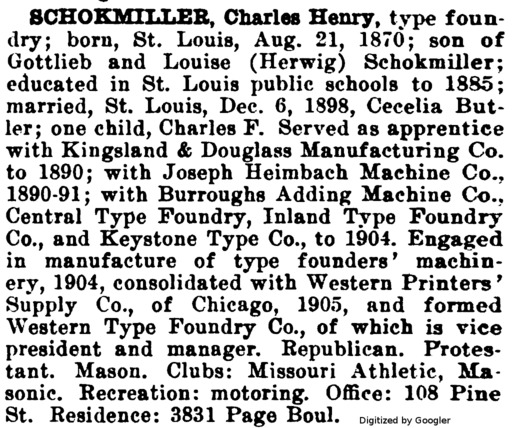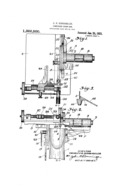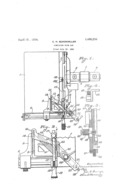Charles H. Schokmiller is of interest historically for three reasons:
The best modern reference for Charles H. Schokmiller is Robert Mullen's history of St. Louis typefounding, Recasting a Craft (2005) . Beyond Mullen's research, a brief biographical paragraph in Marquis' The Book of St. Louisans (Second Edition, 1912) , and some remarks of Nicholas J. Werner, little is known.
Schokmiller, a native of St. Louis, trained with two St. Louis companies: the Kingsland & Douglas Mfg. Co. to 1890 (when he would have been 20) and the Joseph Heimbach Machine Co. (1890-91) { Marquis}.
The biographical sketch in Marquis is then a bit ambiguous. It says that Schokmiller was "with Burroughs Adding Machine Co., Central Type Foundry, Inland Type Foundry Co., and Keystone Type Co., to 1904." Regrettably, it does not say exactly when he was at which company. At the end of this period, 1904, Schokmiller set up on his own and "engaged in [the] manufacture of type founders' machinery." {Marquis}
Mullen suspects, quite reasonably, that Schokmiller might have been at the Inland Type Foundry just prior to 1904 and left it during the 1903-1904 type founders' strike. However, there is another possibility. The "Burroughs" company was formed in St. Louis in 1885/1886 by William S. Burroughs as the American Arithmometer Company. Burroughs himself died in 1898. The company was moved to Detroit in 1904 (in one big move, with all employees, on a specially chartered train) and renamed the "Burroughs Adding Maching Company" after the move. Marquis' reference to it by this name in St. Louis would seem to be anachronistic. But the fact that the American Arithmometer Co. moved out of St. Louis in 1904, at which time there was also a type founders' strike underway, raises the possibility that Schokmiller might have been with the Arithmometer company in 1904 and decided to stay behind.
There is another name-related oddity in Marquis' sketch. It lists him, during this 1891-1904 period, as having worked at the "Keystone Type Co." The Keystone Type Foundry was located in Philadelphia, yet there is no other indication that Schokmiller ever left St. Louis. I would guess that Keystone had a selling house in St. Louis, and that Schokmiller or Marquis remembered them by this name, but this is only a guess. Several sources in the trade literature from the late 1880s refer to the "Keystone Type Company" rather than the "Keystone Type Foundry" (as does the 1934 obituary of one Charles Van Horne, a salesman for that foundry). Annenberg lists selling houses for Keystone in several cities (including Kansas City and Chicago), but none in St. Louis.
So, according to Marquis' biographical sketch Schokmiller began manufaturing type founders' machinery in 1904. This alone is worthy of note, since for the most part type founders' machinery has been bespoke, made by or for typefoundries directly. Third-party manufacturers devoted primarily to this business have been rare. Mullen, who has done extensive research in St. Louis city directories of the period, says that in 1905 he was listed as "printer and manufacturer of type-founders' machinery." (p. 47).
Mullen goes on to describe how in 1906 Schokmiller's company combined with the previously established Western Printers' Supply Company of Chicago and (Mullen quotes from board meeting documents) renamed the combined enterprise the Western Type Foundry. (It should not be confused with the "Great Western Type Foundry" of Barnhart Brothers & Spindler, even though, confusingly, BB&S. later acquired it.) From remarks by remarks by Nicholas J. Werner it is clear that typefounding was done in St. Louis and sales were handled in Chicago.
The other event of significance in 1906 in Schokmiller's life was the export of a matrix engraving pantograph of his own making to the Stephenson, Blake type foundry in England. Werner says that he (Werner) went to England to install the machine and that it was still in use when he visited again (in the late 1920s or, possibly, very early 1930s). The exact date of this export is unknown, and therefore it isn't quite clear whether it predates the merger of Schokmiller and the Western Printing Equipment Co. Since the Western Type Foundry did not continue marketing typefounders' machinery, however, it seems proper to credit it to Schokmiller.
The influences upon Schokmiller in the creation of this pantograph engraver are unknown. He had been associated with the Central Type Foundry, which first cut matrices pantographically in 1882 and with Werner, who worked with Central and later continued to cut type using that equipment (first as a partner in Schroeder & Werner and then on his own). Schokmiller was also associated throughout the lifetime of the Western Type Foundry with Wiebking, who had developed what became, after Benton's, the second most important pantograph engraving machine in America (I have found no evidence as yet, though, that Schokmiller knew Wiebking by 1906). Still, the indications are that Schokmiller was highly regarded as a machinery maker, and he did operate for two years independently as a maker of type founders' equipment. There is no reason to assume that this pantograph was anything other than his own.
In this same period it would seem that Schokmiller was more involved with building type casting machines than pantographs. Nicholas J. Werner, in Werner, N. J. "St. Louis' Place on the Type-Founders' Map." The Inland Printer. Vol. 79, No. 5 (August 1927): 764-766. says that "Today the best hand power and electric power type-casting machiens, aside from those automatically doing all the work (i.e., producing finished type) are those which were perfected in Saint Louis. At one time the Keystone Type Foundry, of Philadelphia, engaged Mr. Schokmiller to superintend the construction of sixty of these machines for its plant, to replace its former machines, which went to the junk pile. Mr. Schokmiller also built one in St. Louis for a type founder in India." (766)
(See also the main Notebook for Schokmiller Type Casting Machines, though at present it has no information beyond what is here.)
The Western Type Foundry was purchased in 1918 by Barnhart Brothers & Spindler (which had been owned by ATF since 1911, although it was still operating under its own name).
In 1921, Schokmiller started the Laclede Type Foundry Mullen indicates that Wiebking cut several faces for this new, short-lived, operation. In 1923 it, too, was purchased by Barnhart Brothers & Spindler.
In his 1927 article "Saint Louis' Place on the Typefounders' Map.", Werner writes of "the recent death in Saint Louis of its last active type founder, Charles H. Schokmiller."
This is the biographical sketch of Schokmiller which appeared in The Book of St. Louisans (Second Edition, 1912) , p. 532:
"SCHOKMILLER, Charles Henry, type foundry; born, St. Louis, Aug. 21, 1870; son of Gottlieb and Louise (Herwig) Schokmiller; educated in St. Louis public schools to 1885; married, St. Louis, Dec. 6, 1898, Cecilia Butler; one child, Charles F. Served as apprentice with Kingsland & Douglass Manufacturing Co. to 1890; with Joseph Heimbach Machine Co., 1890-91; with Burroughs Adding Machine Co., Central Type Foundry, Inland Type Foundry Co., and Keystone Type Co., to 1904. Engaged in manufacture of type founders' machinery, 1904, consolidated with Western Printers' Supply Co., of Chicago, 1905, and formed Western Type Foundry Co., of which is vice president and manager. Republican. Protestant. Mason. Clubs: Missouri Athletic, Masonic. Recreation: motoring. Office: 108 Pine St. Residence: 3831 Page Boul."

(Digitized by Google from the NYPL copy. The snipped above links to a PDF of the full page extracted from the volume.)
This note appeared in The American Printer Vol. 44, No. 3 (May 1906) in the "Talk of the Trade" section : "Recently legal papers have been filed whereby a consolidation is effected between the Western Printers' Supply Company, of Chicago, and C. H. Schokmiller, of St. Louis. Mr. Schokmiller will have charge of the type foundry in St. Louis, and will represent the new company's interests there, the main office continuing in Chicago. It is the purpose of the company to produce type and other material equal to the best made. The Western Printers' Supply Company was incorporated in 1901." (p. 333)

(Digitized by Google from the University of Michigan copy. The snipped above links to a PDF of the full page extracted from the volume.)
Less specifically, Walden's Stationer and Printer ["Formerly The New England Stationer and Printer]" Vol. 25, No. 6 (April 10, 1906): 38 carried this notice: "The Western Printers' Supply Company, 116 Sherman Street, St. Louis, has consolidated its business with C. H. Schokmiller, dealer in printing machinery and supplies in the same city."

(Digitized by Google from the NYPL copy. The snipped above links to a PDF of the full page extracted from the volume.)
This note appeared the "Printing Trade News of the Country" section of Printing Trade News Vol. 40, No. 12 (March 25, 1911): 14.: "Chas. Schokmiller, the manager of the Wetern Type Foundry, has been ill but is convalescing. William O. Peterson, a member of the Chicago force of the Western, took charge of the foundry during the managers' [sic] enforced layoff." Annenberg lists William O. Peterson as the Secretary-Treasurer of the Western Type Foundry. Mullen lists him as one of the three major stockholders of the Western Printers' Supply Co. (p. 47).
(Digitized by Google. The snipped above links to a PDF of the full page extracted from the volume.)
C. H. Schokmiller is listed in The St. Louis Chamber of Commerce Roster (St. Louis, MO: St. Louis Chamber of Commerce, 1918-06-01) as being associated with the Western Type Foundry, 108 Pine Street. (pp. 64, 141, 189).
A look via Google "Street View" in late 2012 indicates that Schokmiller's once lovely house at 3831 Page Blvd is, sadly, boarded up and uninhabited. The former Western Type Foundry location at 108 Pine Street would seem to be occupied by a modern building.
I have been able to discover no patents by Schokmiller for type casting or matrix making machinery. He did, however, take out two patents for improvements in printers' saws.

US 1,366,500. "Composing-Room Saw." (1921)
US patent 1,366,500, "Composing-Room Saw." Issued 1921-01-25 to Charles H. Schokmiller. Filed 1919-04-30 as application serial number 293,812. Not assigned.

US 1,490,234. "Composing-Room Saw." (1924)
US patent 1,490,234, "Composing-Room Saw." Issued 1924-04-15 to Charles H. Schokmiller." Filed 1921-07-18 as application serial number 485,688. Not assigned.
[American Printer] "Talk of the Trade" [column] The American Printer ["with which is incorporated The International Printer"] Vol. 44, No. 3 (May 1906): 333.
Annenberg, Maurice. Type Foundries of America and their Catalogs. Second Edition. (New Castle, DE: Oak Knoll Press, 1994)
Marquis, Albert Nelson, ed. The Book of St. Louisans: A Biographical Dictionary of Leading Living Men of the City of St. Louis and Vicinity . Second Edition. Chicago: A. N. Marquis & Co., 1912.
I am confused by one aspect of the publishing history of this source. The first edition (1906) was edited by John W. Leonard and published by "The St. Louis Republic" in St. Louis. The second edition was edited by Albert Nelson Marquis and published, as noted above, by Marquis in Chicago in 1912. Both editions are available online via Google Books. There is no entry for Schokmiller in the 1906 first edition. Mullen cites the 1912 second edition as edited by Leonard, but I suspect that he meant Marquis.
Mullen, Robert A. Recasting a Craft: St. Louis Typefounders Respond to Industrialization . (Carbondale, IL: Southern Illinois University Press, 2005)
[Printing Trade News] "Printing Trade News of the Country" [section] Printing Trade News Vol. 40, No. 12 (March 25, 1911): 14.
Werner, Nicholas J. "An Address by N. J. Werner of St. Louis." St. Louis, MO: [St. Louis Club of Printing House Craftsmen], [probably] 1931.
Werner, N. J. "St. Louis in Typefounding History." Share Your Knowledge Review, Vol. 22, No. 3 (January 1941): 21-26.
The "Address" (probably of 1931) and the 1941 "St. Louis in Typefounding History" are the same. Both are reprinted in the Werner Notebook.
[Walden's] "Chicago Notes" [column] Walden's Stationer and Printer ["Formerly The New England Stationer and Printer]" Vol. 25, No. 6 (April 10, 1906): 38.
All portions of this document not noted otherwise are Copyright © 2012 by David M. MacMillan and Rollande Krandall.
Circuitous Root is a Registered Trademark of David M. MacMillan and Rollande Krandall.
This work is licensed under the Creative Commons "Attribution - ShareAlike" license. See http://creativecommons.org/licenses/by-sa/3.0/ for its terms.
Presented originally by Circuitous Root®
Select Resolution: 0 [other resolutions temporarily disabled due to lack of disk space]